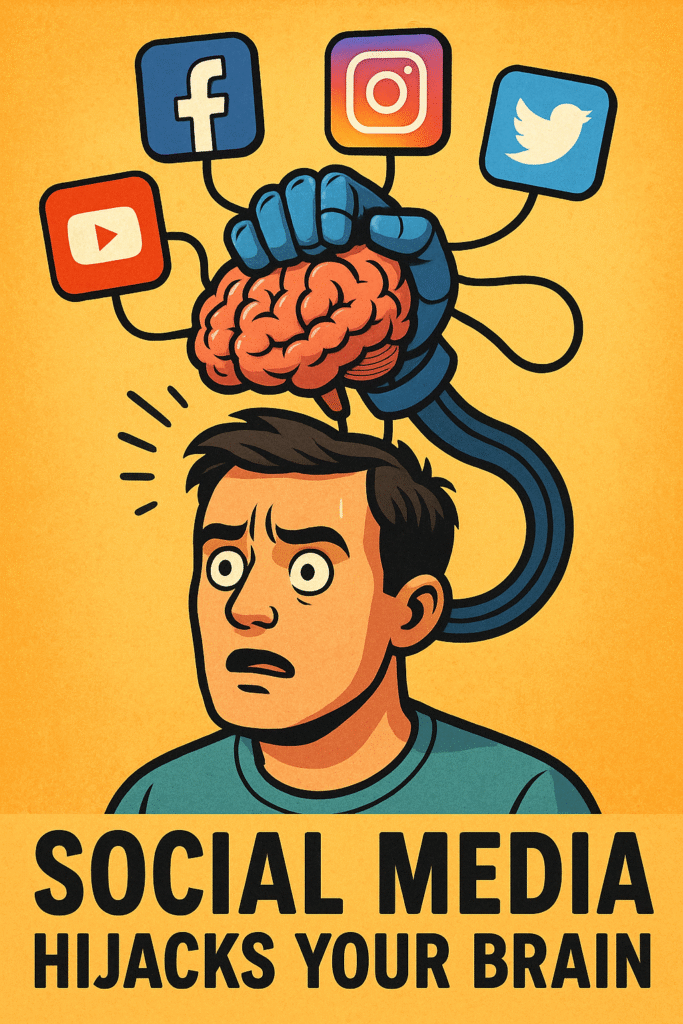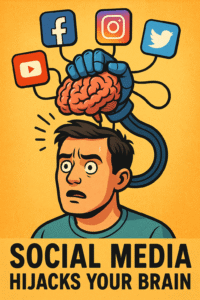Fun fact: Even the inventor of infinite scroll regrets creating it because of its addictive impact.

1. Brain Rot and Word of the Year 2024 Introduction:
- The Word of the Year 2024, selected by Oxford, is brain rot.
- The so-called brain rot is the condition when people feast on extremely overstimulating, low-quality information, mostly in social media, leading to the loss of the connection with reality. It shows the negative influence of the overexposure to shallow online information on human thinking and concentration
2. The Rise of Low-Quality Content and the Fall of Focus:
- More of the awards This majorly interferes with concentration and attention span, as observed with social media, particularly that of short form (such as reels).
- The story tells us how an innocent desire to learn is ruined by social media alerts and endlessly scrolling through reels, political videos, and dark comedy. The habit splits the attention, and it is not easy to have concentration again, which may take a maximum of 20 minutes. This issue is typical of youth, and most of them do not realize their addiction, which is said to be worse than drug addiction. Not even the creator of endless scroll has any regrets about this invention.
3.Policies and the Mainstream of Short-Form Content in the Governments:
- TikTok was also set to be replaced by the Indian government, which feared addiction to short-format materials.
- One of the most popular short-video apps, TikTok, was banned since it had an overbearing impact on young people in India. There are over 1 billion reels consumed on the internet, which means that short-form content consumption rules the internet. These chat apps, formerly photo-sharing apps, have now turned into an outlet of brainless content that is aimed to attract you as a user. The internal documents published by Meta showed that the use of social media is skyrocketing and has a significantly negative effect on communication and behavior in adolescents.
4. Individual and Community Effect of Too Hard Tapping

- More screen time is associated with the increase of myopia and changes in behavior.
- The technological age can hardly allow us to avoid screens, particularly children who are dependent on phones and laptops. And as the screen time increases, there is a rising trend of myopia (nearsightedness), with an anticipated 50 % of the world population expected to be myopic by the year 2050. The social impact consists of the changed communication pattern, emotional alteration, and lack of focus.
5. Digital Addiction: When Focus Becomes a Luxury
- The categories of people whose attention spans no longer exceed 8 seconds are individuals who are being overstimulated digitally.
- It has been found that such unending exposure to short videos has lowered human attention spans below that of the goldfish. The personal example of the author displays the inability to use long-format media such as movies. Gen Alpha is exposed to major cognitive challenges as they spend more than 4 hours per day on social media. In a study that follows brain activity with MRI, there was more activity in the markers of addiction and modified regions in the brain that deal with decisions and emotional inhibition.
6. Dopamine Overdrive: The Reward System Hijacked
- The short-form content causes the unhealthy release of dopamine and creates addiction.
- The effect of reels on the brain is to turn on the reward system, causing a flood of dopamine, which gives immediate satisfaction similar to drug addiction. The unpredictable reinforcement timing (curiosity about whether to check the next video) makes the users addicted. Healthy dopamine comes out of activities that are hard work (such as exercise or learning), and unhealthy dopamine is associated with rapid, overstimulating activities (such as scrolling reels, junk food, and gambling). Overstimulation leads to the unattractiveness of normal activities, and this leads to dependency on digital stimulus.
7. Overload vs. Deep Thinking: The Battle for Mental Clarity
- The repetitive switching stimuli undermine the ability of the brain to focus and process information on an in-depth level.
- Cognitive overload develops after switching between content at a very high frequency and does not allow engaging meaningfully with other tasks that need to be addressed with long-term attention. To the brain, constant stimulation is more preferable than hard work, so reading or working creatively appears to be dull. This is supported by experiments proving that users enjoy a sequence of different short clips instead of a single long video, increasing dopamine-driven actions and lowering mental stamina.
8. Boredom: The Lost Art That Sparks Innovation
- Boredom is an inspirer of creativity and is becoming uncommon in the digital age.
- Self-reflection and creative thinking are possible through boredom, and they are fundamental in mental well-being. But today, due to the constant presence of digital distractions, a person hardly has time to feel bored. There are historical precedents that prove that boredom has led us to innovations (i.e., the invention of the World Wide Web and discoveries made by Newton). Modern children who have lived all their lives with a screen in front of their face are not getting the mental workout they should have through boredom, and this can affect their cognitive and emotional growth.
9. YouTube, Children, and the Problem with Hyperstimulating Content
- Hyperstimulating content is dangerous and hastily produced content presented on platforms, like YouTube, is directly affecting how these children develop.
- As we talked about previously, children are now exposed to hyperstimulating content, which is fast-paced and often utilizes bright colors and loud music – think channels like Coco Melon and then some of the various gaming or horror channels out there. It is clear from these channels they are created for quantity not quality, with even some of the channels presenting violent or adult themes. Compound this with YouTube’s autoplay for addicted viewing and we are left with a disjointed form of media with hyperstimulating content that inhibits their ability to concentrate on a creative task such as reading or writing, only can see “engaging” content. The child gets conditioned to always have that “streaming stimulation” to see “fun engaging” content on demand.
10. Solutions: Breaking the Cycle Without Breaking Down
- An all-at-once social media detox isn’t going to be useful; instead, cut back gradually.
- It’s very common for many of these videos to suggest deleting social media altogether to deal with addiction; however, studies have shown that quitting altogether isn’t feasible in the short term and not likely in the long-term. The better approach would be cutting back on reels and short-form content time, one minute at a time daily. Users are also encouraged to self-track and share their usage with others to shed light on the issue. The message from the video creator is to face the contradiction of putting this video out on social media, while not sharing any of their social handles—which was done in order to stay on point and not get distracted from it.
Conclusion:
- This comprehensive overview details the detrimental cognitive, emotional, and physical effects of over-consumption of short-form digital content, especially in youth. It emphasizes developing awareness, a gradual approach to behavioral change, and novel approaches, including specialized eyewear, to address related health issues. The key message is to maintain a healthy digital diet to protect mental wellness, creativity, and attention in a rapidly hyperstimulated environment.



